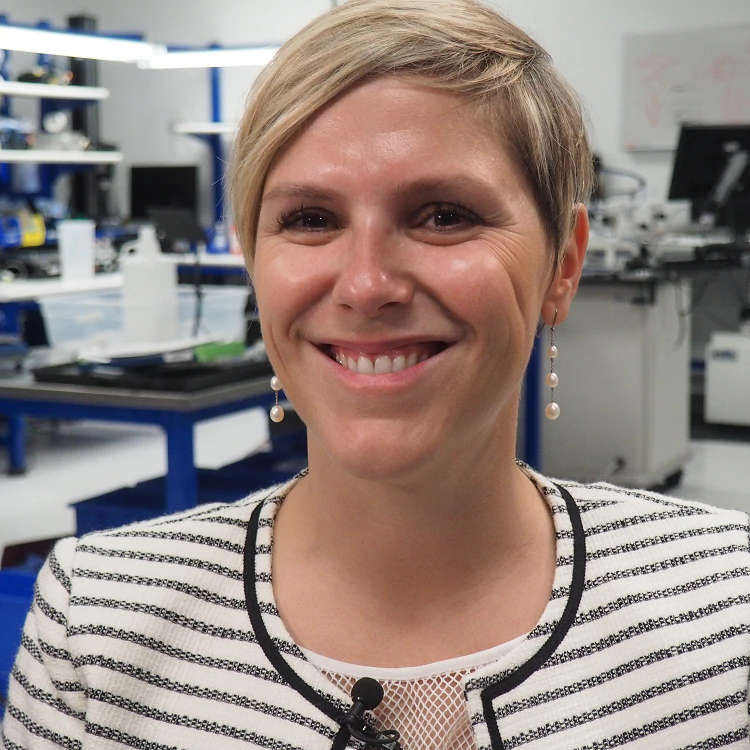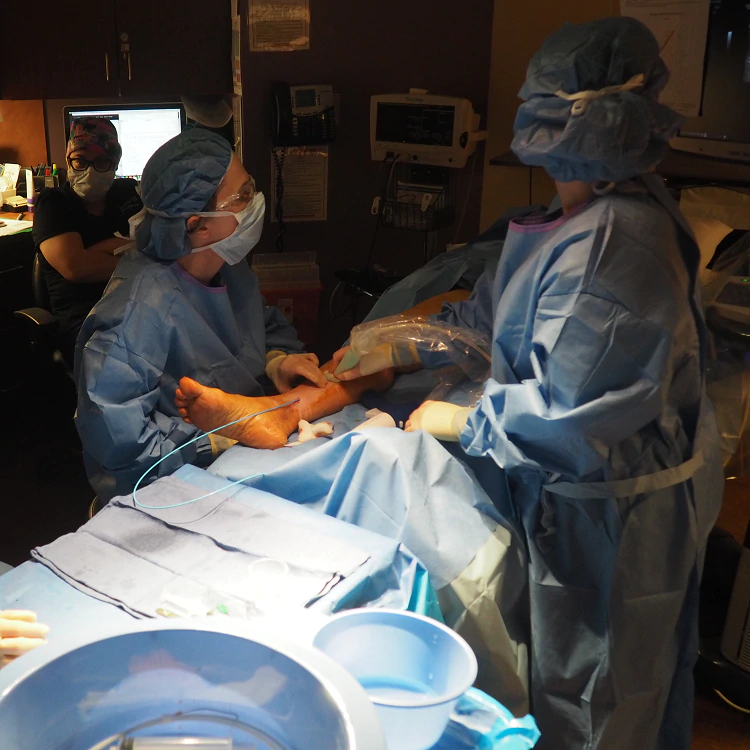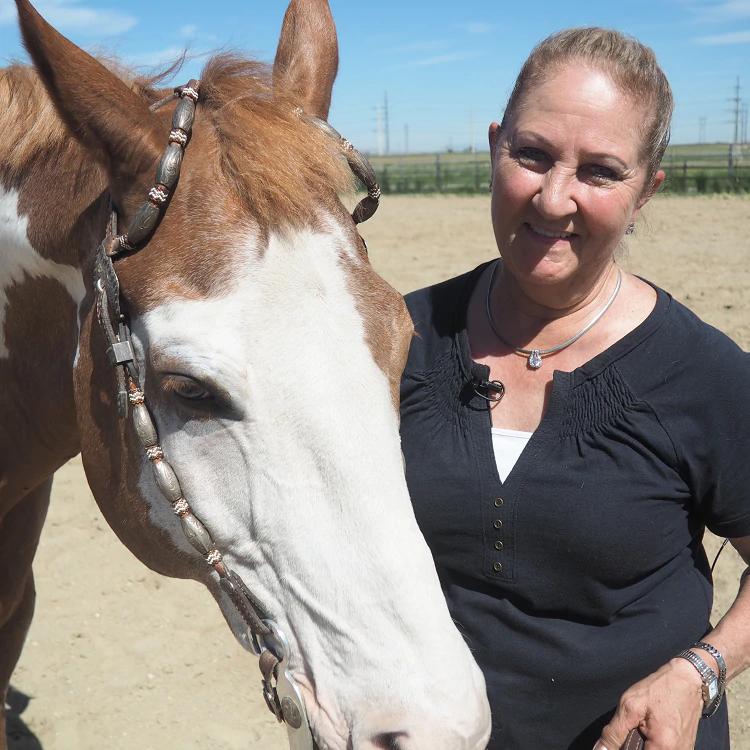Beyond Appearances: New Treatment for Painful Leg Veins Helps Get Patients Back on Their Feet
New treatment for painful leg veins helps patients get back on their feet.
Bonnie Christensen has loved horses all her life. “They’re everything to me,” she said.
But there was a time when Bonnie feared she would no longer be able to care for, or even ride, the horses she tends to on her property just outside Salt Lake City, Utah.
A leg bruise that wouldn’t heal had turned into an open sore and left her in excruciating pain.
“On a scale of 1 to 10, it was probably a 12,” she said. “It hurt so bad.”
She struggled to care for her horses and stopped riding them altogether. The pain also slowed her down at work; her job at the local farm store meant she was on her feet eight hours a day. “Every step was painful. The worst pain I’ve ever experienced,” she said.
I didn't really realize all the things I couldn't do until I could do them again.
Bonnie Christensen, who received VenaSeal therapy in Salt Lake City, Utah
Chronic Venous Insufficiency
Doctors eventually diagnosed Bonnie with chronic venous insufficiency, or CVI. A vein that carried blood back to her heart stopped working properly and caused the blood to pool in her veins. That can cause swelling and pain and in Bonnie’s case, it developed into an open, ugly wound. “It looked horrible,” she said.
Bonnie’s doctor used a Medtronic product called the VenaSeal™ Closure System to treat her condition. Using ultrasound as a guide, surgeons inserted a catheter into the diseased vein, then methodically injected a medical adhesive to seal it.
“It glues the bad vein shut, wall to wall,” said Dr. Kathleen Gibson, medical director of Lake Washington Vascular Surgeons in Bellevue, Washington. “Then the blood that was flowing through the pathway that wasn’t working correctly will immediately divert itself to the deep veins in the muscle where the blood flow is more efficient.”
Dr. Gibson is an expert in the treatment of CVI. She now uses VenaSeal to treat many of her CVI patients.
A local anesthetic is used at the insertion site and patients do not require sedation.
A typical appointment takes less than an hour; patients experience minimal discomfort and can walk out as soon as it’s over.
“In my experience, a majority of my patients are able to go back to their regular activities on the same day – we don’t put any restrictions on their activity afterwards,” said Dr. Gibson.
Common Issue for Both Men and Women
It’s estimated 20 to 30 percent of Americans — women and men — suffer from CVI.1 But because CVI often presents as varicose veins, many people delay seeking treatment because they consider it a cosmetic issue.
For Bruce Schmidt of Minneapolis, CVI started as a tightness in his ankle. Within two weeks it had progressed to a painful, open sore.
“It felt like 100 needles were poking me in the ankle,” he said. “Being on my feet at work was difficult and at home I would sit in the house and not want to do anything. The pain was constant.”
Schmidt also underwent a VenaSeal procedure and within three days, the pain that had plagued him for months in his ankle was gone. “I’m back to normal,” he said.
Patients who undergo other types of procedures using heat to close the vein, like laser-based therapies, can sometimes experience nerve injury due to heat and require longer recovery times.2
Furthermore, a recent study found VenaSeal equally effective as radiofrequency ablation (RFA) – what has previously been considered the gold standard – at five years.3
“VenaSeal is a good therapy for patients who want to have an easier recovery and with a shorter downtime4,5 compared to other treatment options,” Dr. Gibson said.
A majority of my patients are able to go back to their regular activities on the same day. We don’t put any restrictions on their activity afterwards.
Dr. Kathleen Gibson, medical director of the Washington Vascular Surgeons in Seattle, Washington
Cost to the Healthcare System
It’s estimated that it costs the U.S. healthcare system up to $2 billion a year to treat CVI.6 Indirect costs, such as lost work productivity, cost $15 billion more every year.7
“Early intervention is critically important,” said Sandra Lesenfants, vice president and general manager of the Venous business at Medtronic. “If we can prevent this disease from progressing to a venous leg ulcer, we not only benefit patients, but we’re also providing an economic benefit to the healthcare system,” she said.
More than 100,000 VenaSeal procedures have been completed worldwide. But only recently — beginning in January of 2018 — did VenaSeal receive coverage by most U.S. Medicare providers and some private health insurance companies. The result has been a dramatic increase in adoption of the therapy — up 767 percent in just one year since coverage went into effect. Still, only 1 percent of Americans who could benefit from venous interventions, including VenaSeal, have actually received treatment.8
“We pay a lot of attention to diseases that cause death and maybe not enough to diseases that cause disability and impact quality of life,” said Dr. Gibson. “Millions of people could potentially benefit from this therapy.”
It worked out so well for Bonnie that she's back to riding her beloved horses again.
“I didn’t really realize all the things I couldn’t do until I could do them again,” she said. “This procedure changed my life completely.”
Treatment with VenaSeal Closure System is prescribed by your physician. Your physician should discuss all potential benefits and risks with you. Results may vary. This story represents individual experiences with the VenaSeal Closure System.
1https://www.ahajournals.org/doi/full/10.1161/CIRCULATIONAHA.113.006898
2 Proebstle, T.M. The European Multicenter Study on Cyanoacrylate Embolization of Refluxing Great Saphenous Veins without Tumescent Anesthesia and without Compression Therapy. Results presented at Charing Cross; 2016; London, UK.
3Morrison, N. VeClose Five-Year Extension Follow-Up Study Results. Results presented at: Charing Cross Symposium; 2019; London, UK. 4Morrison N, et al. Randomized Trial Comparing Cyanoacrylate Embolization and Radiofrequency Ablation for Incompetent Great Saphenous Veins (VeClose). J Vasc Surg. 2015;61(4):985–994. 5Proebstle, T.M. The European Multicenter Study on Cyanoacrylate Embolization of Refluxing Great Saphenous Veins without Tumescent Anesthesia and without Compression Therapy. Results presented at Charing Cross; 2016; London, UK. 6https://www.ahajournals.org/doi/full/10.1161/01.cir.0000164199.72440.08 7Rice J (2014). Burden of venous leg ulcers in the United States. Journal of Medical Economics. 17(5), 347-356 8Lee, A. US markets for varicose vein treatment devices 2011. Millennium Research Group, Inc. (A Decision Resource, Inc. Company), www.mrg.net, May 2011
Important Safety Information
INTENDED USE/INDICATIONS
The VenaSeal™ Closure System (VenaSeal™ System) is indicated for use in the permanent closure of lower extremity superficial truncal veins, such as the great saphenous vein (GSV), through endovascular embolization with coaptation. The VenaSeal System is intended for use in adults with clinically symptomatic venous reflux as diagnosed by duplex ultrasound (DUS).
CONTRAINDICATIONS
Separate use of the individual components of the VenaSeal Closure System is contraindicated. These components must be used a system. The use of the VenaSeal system is contraindicated when any of the following conditions exist: previous hypersensitivity reactions to the VenaSeal™ adhesive or cyanoacrylates, acute superficial thrombophlebitis, thrombophlebitis migrans, acute sepsis.
POTENTIAL ADVERSE EFFECTS OF THE DEVICE ON HEALTH
The potential adverse effects (e.g., complications) associated with the use of the VenaSeal system include, but are not limited to, allergic reactions to cyanoacrylates, such as hives, asthma, hay fever and anaphylactic shock, arteriovenous fistula, bleeding from the access site, deep vein thrombosis (DVT), edema in the treated leg, embolization, including pulmonary embolism (PE), hematoma, hyperpigmentation, infection at the access site, non-specific mild inflammation of the cutaneous and subcutaneous tissue, pain, paresthesia, phlebitis, superficial thrombophlebitis, urticaria or ulceration may occur at the injection site, vascular rupture and perforation, visible scarring.
Instructions for use can be found in the product labeling at http://manuals.medtronic.com
CAUTION: Federal (USA) law restricts these devices to sale by or on the order of a physician.




